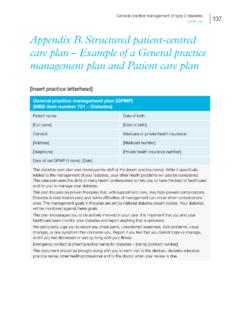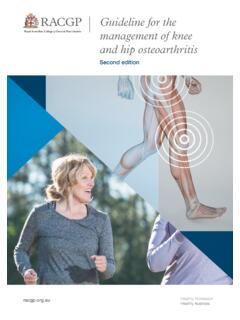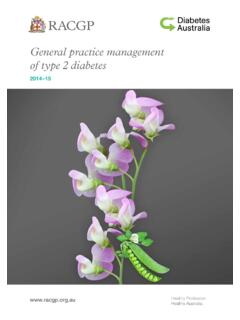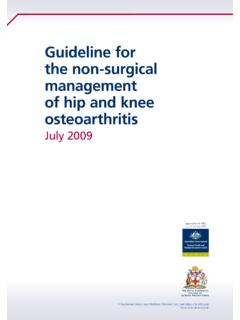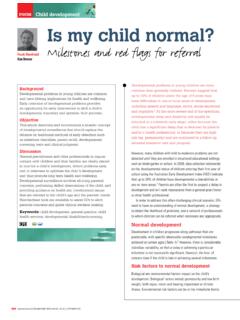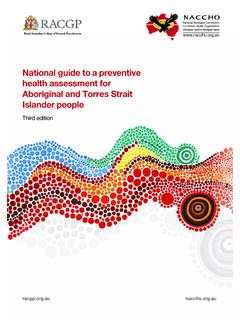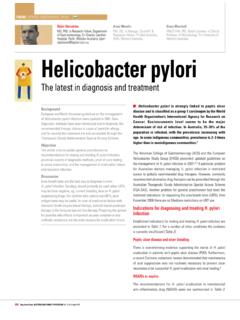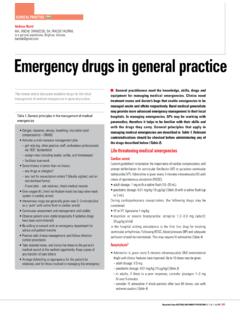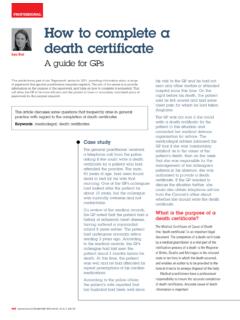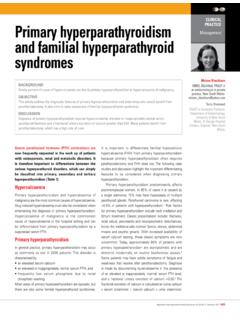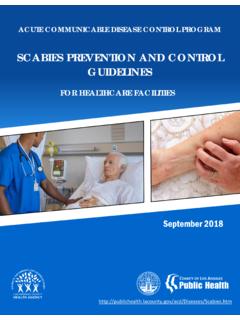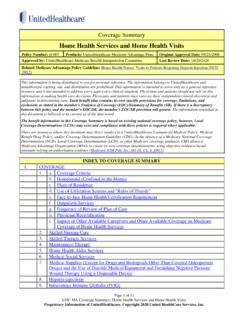Transcription of Home-care guidelines for adult patients with mild COVID-19
1 guidelines for adult patients with mild COVID-19 Home-care guidelines for adult patients with mild COVID-19 DisclaimerThe information set out in this publication is current at the date of first publication and is intended for use as a guide of a general nature only and may or may not be relevant to particular patients or circumstances. Nor is this publication exhaustive of the subject matter. Persons implementing any recommendations contained in this publication must exercise their own independent skill or judgement or seek appropriate professional advice relevant to their own particular circumstances when so doing. Compliance with any recommendations cannot of itself guarantee discharge of the duty of care owed to patients and others coming into contact with the health professional and the premises from which the health professional the text is directed to health professionals possessing appropriate qualifications and skills in ascertaining and discharging their professional (including legal) duties, it is not to be regarded as clinical advice and, in particular, is no substitute for a full examination and consideration of medical history in reaching a diagnosis and treatment based on accepted clinical , The Royal Australian College of General Practitioners Ltd (RACGP) and its employees and agents shall have no liability (including without limitation liability by reason of negligence)
2 To any users of the information contained in this publication for any loss or damage (consequential or otherwise), cost or expense incurred or arising by reason of any person using or relying on the information contained in this publication and whether caused by reason of any error, negligent act, omission or misrepresentation in the citationThe Royal Australian College of General Practitioners. Home-care guidelines for adult patients with mild COVID-19 . East Melbourne, Vic: RACGP, Royal Australian College of General Practitioners Ltd 100 Wellington Parade East Melbourne, Victoria 3002 Tel 03 8699 0414 Fax 03 8699 0400 : 34 000 223 807 ISBN: 978-0-86906-582-2 Published August 2020 The Royal Australian College of General Practitioners 2021 This resource is provided under licence by the RACGP. Full terms are available at In summary, you must not edit or adapt it or use it for any commercial purposes.
3 You must acknowledge the RACGP as the acknowledge the Traditional Custodians of the lands and seas on which we work and live, and pay our respects to Elders, past, present and 1428 Home-care guidelines for adult patients with mild COVID-19 | iContents1. Background 12. Patient results and notification 13. Patient triage and clinical care overview 24. Home-care suitability assessment 35. Developing a management plan 66. Managing symptoms and medicines 77. Monitoring symptoms 88. Escalating care 109. Conducting telehealth consultations 1110. Conducting a face-to-face consultation Infection prevention and control Additional considerations for face-to-face consultations taking place at a general practice 1211. General advice for pregnant or breastfeeding patients 14 Additional resources 14 References 15 Home-care guidelines for adult patients with mild COVID-19 | 11.
4 BackgroundPeople who test positive for COVID-19 are most likely to only experience mild symptoms and recover without requiring special treatment or guide contains information for general practitioners (GPs) who are providing home -based care in a private residential home (including public or community housing) for adult patients who have tested positive for COVID-19 and who are asymptomatic or have mild symptoms. Caring for patients with COVID-19 in their homes allows the provision of appropriate care , minimises the impact on the healthcare system and frees up hospital beds for patients with moderate or severe processes that facilitate timely and adequate communication and clinical handover to GPs and their teams should be in place when a COVID-19 -positive patient is discharged from hospital into home states/territories will have models of care that allow remote supervision of patients , which cover escalation pathways for intervention and admission to hospital if required.
5 These models of care ensure patients receive the required services and supports based on their healthcare requirements, preferences and other document is generic, interim guidance for GPs and should be used to support any local or other more contemporaneous advice, acknowledging that in this rapidly changing pandemic environment, uncertainties remain in our understanding of the spread of COVID-19 and its Patient results and notificationGPs may become aware of a COVID-19 -positive patient in their care through the receipt of: a positive result following GP-initiated testing notification from the local public health unit after testing initiated by another agency discharge notification regarding a patient hospitalised with is a notifiable disease in all states and territories. The doctor requesting the SARS-CoV-2 nasopharyngeal testing is responsible for notifying the patient and local public health unit of a positive result.
6 If another agency has requested the test, they are also responsible for notifying the patient s nominated GP of the | Home-care guidelines for adult patients with mild COVID-193. Patient triage and clinical care overviewIf a patient tests positive for COVID-19 , the severity of their illness (refer to Box 1) will need to be determined to ensure appropriate care is provided in the appropriate location. Local factors such as remoteness, resources, escalation pathways and access to health services will influence this decision. Many regions will have local processes documented on their HealthPathways for the location of care for patients with mild COVID-19 can include: care in a private home , residential facility or temporary accommodation using telehealth and remote monitoring, and face-to-face clinical contact as required admission into a hospital diversion program such as hospital in the home admission to hospital (for those at higher risk, including the elderly and those with chronic disease or compromised immunity).
7 A decision regarding home care will be based on the processes of the local public health unit, local hospital service or other jurisdictional agency, as well as the patient s symptom severity, risk factors and home who are not involved in COVID-19 management processes should still manage the patient s usual healthcare and be kept up to date on the patient s care plans. However, if a patient is admitted to hospital (including hospital in the home ), the GP is not able to provide any Medicare Benefits Schedule-funded services during that admission. Some regions have resolved this issue by managing these patients as guidelines for adult patients with mild COVID-19 | 34. Home-care suitability assessment Currently in the majority of Australian regions Home-care suitability is determined by public health units and the local hospital -supported community care processes.
8 With increasing disease prevalence, the role of the GP in patient Home-care assessment may be of increasing importance. The following factors are currently used to determine location of severityRefer to Box 1 for the current disease severity only patients with mild illness are cared for in the 1. Definition of disease severity for adults Mild illnessAdults not presenting any clinical features suggestive of moderate or severe disease or a complicated course of : no symptoms; or mild upper-respiratory tract symptoms; or cough, new myalgia or asthenia without new shortness of breath or a reduction in oxygen saturationModerate illnessStable adult patients presenting with respiratory and/or systemic symptoms or signs. Able to maintain oxygen saturation (SpO2) above 92% (or above 90% for patients with chronic lung disease) with up to 4 L/min oxygen via nasal : prostration, severe asthenia, fever >38 oC or persistent cough clinical or radiological signs of lung involvement no clinical or laboratory indicators of clinical severity or respiratory impairmentSevere illness adult patients meeting any of the following criteria: respiratory rate 30 breaths/min oxygen saturation 92% at a rest state arterial partial pressure of oxygen (PaO2)/inspired oxygen fraction (FiO2) 300 Critical illnessAdult patient meeting any of the following criteria.
9 Respiratory failure occurrence of severe respiratory failure (PaO2/FiO2 <200), respiratory distress or acute respiratory distress syndrome (ARDS), including patients deteriorating despite advanced forms of respiratory support (non-invasive ventilation [NIV], high-flow nasal oxygen [HFNO]) or patients requiring mechanical ventilationOR other signs of significant deterioration hypotension or shock impairment of consciousness other organ failureReproduced with permission from: National COVID-19 Clinical Evidence Taskforce. Australian guidelines for the clinical care of people with COVID-19 . 2020 [version 15]. Available at 4 | Home-care guidelines for adult patients with mild COVID-19 Patient health factors Does the patient have any risk factors for adverse outcomes or severe COVID-19 ? (refer to Box 2) What other health conditions need to be monitored and managed?
10 Are there any cultural and social factors that may affect compliance with self-isolation and infection control measures? Does the patient or their carer have an adequate understanding of their illness and medical guidance (health literacy)? How easily can the patient be moved if their condition deteriorates?Box 2. Established and potential risk factors for severe COVID-192 The following are determined to be risk factors for severe COVID-19 : Older age (>65 years) Chronic lung disease Cardiovascular disease Diabetes mellitus Obesity Immunocompromised status End-stage renal disease Liver disease Cancer Smoking historyAccommodation/household factors Does the patient have suitable accommodation and access to food, medicines and essential supplies? If needed, is there a caregiver who can provide support and help cover the patient s basic needs?
